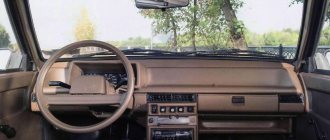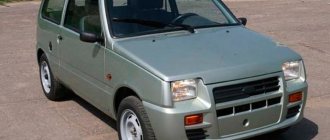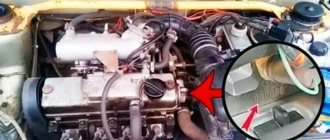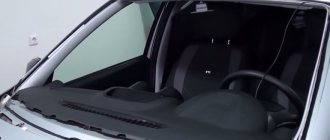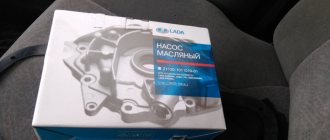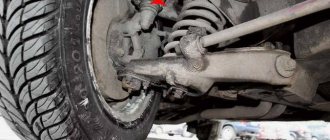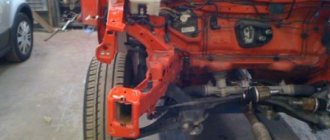The VAZ-2113 car is a three-door hatchback produced by the Volzhsky Automobile Plant. This is a budget model with decent technical and driving characteristics, suitable for young people planning to purchase a vehicle as their first learning car, or for citizens with low incomes who cannot afford an expensive foreign car. Considering the vastness of the family of VAZ cars, many people confuse various examples, in particular the “thirteenth” model with the usual “eight”, but before we take a closer look at what the “thirnashka” car looks like, it’s worth knowing the history of this legendary car.
VAZ 2113: History of creation
This car is an advanced analogue of the famous VAZ-2108 car, which at one time became a real mainstream of the Soviet automobile industry. The G8, released in 1984, became not only one of the first front-wheel drive Soviet cars, only the LUAZ-969V appeared before it, produced by the Lutsk Automobile Plant from 1966 to 2002 and an innovative model for its time.
It was with the G8 that a completely new era began for VAZ cars, which finally abandoned copying Fiat models and created a product with its own design and interior.
Actually, the exterior was developed by VAZ specialists - Vladislav Pashko and Viktor Kryazhev, under the leadership of chief designer Mark Demidovtsev. The interior was created by Vladimir Guba, a VAZ employee who completed an internship in Germany at the plant of the world famous company Porsche.
VAZ-2113 – front view
It was the G8 that became the first-born in the long-lived dynasty of Lada Samara cars. This family includes model 2109, the same hatch, but a five-door, the series of which started in 1987, as well as the most prestigious Russian sedan of the 90s - Lada Samara 21099. At the beginning of the 2000s, the entire line was restyled and, accordingly, each model of the family acquired a new index in the name.
Thus, the updated version 2108 received the index 2113, that is, the model that we are considering in this article.
In fact, the VAZ-2113 is not a full-fledged generation change of the G8, but only its restyling on the previous platform - Gamma.
Simply put, the developers largely retained the body contours of the G8, but still carried out a fairly extensive upgrade to the exterior. In addition, they modernized the interior, modernized the engine equipment, completely replacing the carburetor internal combustion engines with more advanced injection engines.
Unreleased VAZ model (9 photos)
A collection of VAZ concepts that will never be included in serial production; looking at them, one becomes completely sad about our domestic automobile industry.
Lada Roadster is a concern of the VAZ automobile plant, not allowed into production. For the first time, the Roadster was noticed at the MIMS 2000 car exhibition in the year 2000. The fundamental idea of the Roadster was the ability to retract the roof of the car into the trunk. Unfortunately, the demand for cars like the Lada Roadster is not great. But car manufacturers have always strived to have a stylish car with improved dynamic performance. AvtoVAZ wanted to implement a similar model on the basis of the 2108 car, which could be called “Lada Studio”. The car had a separate trunk and a removable roof. In the end, the car was completely redesigned, and approximately 500 cars were produced, which were delivered only to Europe and sold only there. Because of this unsuccessful model, a new one emerged - to release a high-quality car of the same class, which the Roadster should have been.
Lada Siluet, Lada-Siluet, VAZ-2116 is a concept car of a front-wheel drive sedan on the Project C platform, first demonstrated at the Moscow Automobile Show in 2005. A completely new front-wheel drive platform and a two-liter engine are being developed especially for the project. In the future, Diesel and automatic transmission variants are planned for production. It is alleged that this larger family car will feature an interesting exterior and interior design, high comfort, high-quality materials, neat assembly, enhanced safety, and that it is planned to launch the VAZ-2116 into production in 2015. Currently, crash tests of the prototype have been carried out, showing 13 points out of 16 possible according to the EuroNCAP system. In addition to the VAZ-2116 sedan, the Silhouette family includes the VAZ-2117 station wagon and the VAZ-2118 hatchback.
The new modification of the base model VAZ-2110 is a 4-seater limousine with a fairly high level of comfort characteristic of cars of this type. Various options for completing and finishing the interior of the VAZ 2110 “Consul” car allow you to use it for long tourist and business trips, as a representative car, as a taxi, it is possible to create a modification of the car for celebrations, as well as a version of the car with increased security. The design of the car interior provides a lot for comfortable accommodation of the driver and passengers. A soundproof partition allows you to create an autonomous compartment in the rear with a wide range of additional equipment and services. By increasing the length of the rear doors, free entry and exit of passengers is ensured. The aeroclimatic unit maintains a comfortable temperature regime for the cabin even with significant fluctuations in ambient temperature. Fatigue from a long stay in a static position is reduced by adjusting the position of the rear seats.
The LADA C project is a joint project of AVTOVAZ OJSC and the Canadian company, which provides for the creation of a series of C class cars. Existed in Russia from 2006 to 2009. “Project Lada C” provided for the joint creation of ten series of car models under the Lada brand at the existing facilities of AVTOVAZ. The launch of new models into mass production was scheduled for 2009. It was planned to create a joint venture, which would be headed by one of the Vice-Presidents of Russian Technologies, Maxim Nagaitsev. On December 22, 2006, a framework agreement was signed between the state corporation Russian Technologies and the Canadian company Magna International on cooperation in the production of auto components for the new project C. In 2009, cooperation with the Canadian company Magna International was frozen in favor of the Franco-Japanese Alliance Renault Nissan, the French company Renault acquired a 25% stake in AvtoVAZ. The Alliance provided its B platforms, which in 2012 were installed on the first line of the AVTOVAZ main conveyor. The head of the Russian Technologies company, Sergei Chemezov, said that the developments with Magna International remain in force and will be used to create new cars. Since 2009, due to the difficult economic situation of AvtoVAZ OJSC, “Project C” has been suspended.
Lada Karat is a Russian concept from AvtoVAZ. Introduced in 2002. The first development of the Lada Karat began in 2001. The dimensions of the Karat are not much different from the Oka. Its length is 300 mm longer and it is slightly taller than the Oka.
The prototype of the VAZ-2151 (aka Lada-Classic) was presented at the 2002 Moscow Motor Show. This was an attempt to modernize the classic Zhiguli: a completely new body was installed on the old rear-wheel drive chassis, the front suspension layout was changed, and a 1.7-liter engine with fuel injection was placed under the hood. The steering with a rack and pinion system was also different. Initially, the appearance of the car was supposed to echo the old VAZ-2101 and 2102 models, but in the end it was decided to abandon the round headlights and recognizable silhouette. It was assumed that the VAZ-2151 would not be a replacement, but a complement to the “classic” and would help AvtoVAZ increase production volumes. The start of production of sedans and station wagons was scheduled for 2006... As a result, the project did not receive further development, as it was considered unprofitable.
LADA SAMARA T3
Source: liveinternet.ru
fishki.net
Body
The rear of the model was left almost unchanged, the bumper was only slightly altered, but the front part was subjected to significant modifications. In particular, the wide, rectangular front headlight blocks of the classic “eight” were replaced with narrow oblong monoblocks, round in shape.
Body of VAZ-2113
In addition, the front radiator grille and bumper were changed, which acquired a more complex geometry aimed at reducing drag. Also, the body of the restyled version was equipped with an aerodynamic body kit including the following elements:
- Side moldings;
- Side skirt fairings;
- Spoiler on the rear door.
Similar features were available immediately at release, and in the basic configuration of the model, which certainly pleased buyers.
In general, the body was made more streamlined and elegant, and coupled with additional aerodynamic elements, it was possible to somewhat improve the car’s throttle response and handling at high speeds.
Interior and instrument panel
Some interior details of the G8 have migrated into the cabin, including a molded ceiling and interior door panels. The rest of the decoration, including the two-spoke steering wheel, was borrowed from the restyled versions of the 9 and 99 (VAZ-2114, 2115), which were released a few years earlier.
The instrument panel has changed significantly compared to the G8. The dashboard, as well as the body, received smoother and more elegant lines in contrast to the archaic angular console of the original model.
Dashboard VAZ-2113
VAZ also added additional auxiliary gadgets. The basic assembly offers: vertical steering wheel adjustment, backlight with adjustable brightness level, headlight level control, exterior anti-dazzle mirrors, rear window cleaner and washer, on-board control system with display unit.
Innovations available in the highest trim level - "Lux" - include heated seats, headrests in the rear seats, an on-board computer, and fog lights. Otherwise, the model does not offer any special frills. For example, there is no air conditioning or multimedia system. However, regarding the last aspect, the developers came to the rescue and at least equipped a slot on the panel for installing a radio.
Let's wrap it up: how and why the Lada Samara 2 was created
But time is inexorable: five years after the start of production of the base model, both the “nine” and even the “ninety-nine” no longer looked so fresh and impressive. Neither long fenders, nor a high panel, nor a more powerful one and a half liter engine saved the situation - by the beginning of the 90s, automobile fashion had made an interesting transition from angular shapes and sharp lines to a smoother and calmer design.
For the sake of aerodynamics, the bodies began to float, and the transitions between volumes and planes, on the contrary, lost their obvious expression. Compared to Sputnik’s newest classmates like the Volkswagen Golf III, Opel Astra F, Ford Escort V or Peugeot 306, the angular “chisel” looked, to put it mildly, outdated.
1 / 4
2 / 4
3 / 4
4 / 4
By that time, VAZ had experience in updating rear-wheel drive cars - both as part of cooperation with Fiat on the 2103 , and in deeper modernization, which resulted in the appearance of the fifth Zhiguli family. And world experience suggested that it was too early to retire a model that had only been in production for five years, but it wouldn’t hurt to slightly retouch and rejuvenate its appearance by that time.
was being intensively developed in Tolyatti by that time . However, it became obvious that it would be possible to master the launch of the “ten” in 1996 at best, and before that time you won’t get very far on Samara of the 1984 model alone.
1 / 2
2 / 2
They tried to refresh the Chisel with the help of foreign partners, but neither the numerous dealer variations on the theme, nor the so-called Samara Baltic, produced in Finland at the Valmet plant , looked much more modern than the usual “nine”. The angular body needed not only and not so much various linings and “body kits”, but required a radical revision of the solution of the front and rear parts - again, following all the laws of the genre adopted in the automotive world as part of the restyling of a particular model.
Almost immediately a problem arose - technological limitations. The appearance of the car is determined not only by the front and rear, but also by the roof and side panels. It should be noted that in Samara they were made very straightforward - to suit the fashion of the early eighties. This Italian school of design was called folded paper and was found on many small cars of those years, including His Majesty Golf II.
The roof, floor, sides and doors could not be touched. In fact, the designer Vladislav Ivanovich Pashko, who had previously created the appearance of the first Sputnik together with Viktor Kryazhev, had creative freedom only in the front and rear, and the old car had to “remain” in the middle. Approximately according to the same scheme in the USSR, not only Zhiguli, but also other models were updated - for example, Moskvich (412 > 2140) and Volga (24 > 3102).
1 / 4
2 / 4
3 / 4
4 / 4
The head optics “squinted” in the manner fashionable in the early nineties - the headlights noticeably decreased in height, and the turn signals began to extend onto the side of the wing. The hood also became a much more massive part, because it noticeably increased in length, almost reaching the bumper. Due to this, the front of Samara-2 visually appears lower than that of the first generation car, although the wings do not differ in the base points on the body. The seemingly small increase in overall length and reduction in the height of the headlights really made the front end more dynamic, more modern and attractive.
Facelift: with a new front end solution, the angular Samara has become less original and recognizable, but at the same time it seems to have shed five of its assembly line years.
True, at the same time, the Russian car began to surprisingly resemble the first generation Ford Scorpio, which was the Car of the Year in 1986 - that is, it appeared exactly a year after the release of the first G8.
1 / 3
2 / 3
3 / 3
Be that as it may, the decision on the front part entailed a change in almost all the front elements - the hood, fenders, headlights and radiator trim. The bumper also became completely different - unlike the “indestructible” unpainted part of the first Samara, it was made of a different material and in the color of the body. And if, thanks to the “tinting” of the bumpers, the car became more attractive, then the unexpectedly high fragility of the bumpers and other plastic could hardly please the new owners of Samara-2.
However, first things first. If updating the front part required minimal changes in welding equipment, then with the stern everything was not so rosy. Even while working on the G8, the designers discovered that some additional two degrees in the tilt of the rear window would have greatly reduced its contamination, and at the same time would have reduced the aerodynamic drag coefficient of the body, which Sputnik did not do very well with.
That is why, already as part of the work on updating Samara, the designers planned to use new parts - a roof panel raised by 10 mm without a rear “hump” spoiler, an overhead trunk door with an opening to the bumper, new taillights and (of course!) the rear bumper itself.
Such a package of changes, combined with side sill and door trims, could radically change not only the appearance of the car, but also significantly improve the aerodynamic qualities of the angular body.
After all, it was precisely because of the high ground clearance and not the best streamlining at high speeds that Samara had an enviable fuel appetite, and its maximum speed did not greatly exceed that of the brick-shaped Zhiguli. At the same time, the distribution of lift forces along the axles of the first generation Samara was very good: the results of aerodynamic tests showed that at a speed of 144 km/h, the rear wheels of the VAZ-2108 were pressed to the road with a force of 158 N, and the front wheels were unloaded with a force of 152 N. For comparison: the front of the first-generation Audi TT sports coupe at the same speed lifted off the surface with a force of 163 N, and the rear, without a spoiler, “took off” with a lift-off force of 337 N! Therefore, the designers’ task was further complicated by the fact that the “chisel” had to be made not only more modern in appearance, but also at least not to worsen its aerodynamic performance.
Articles / Sedan Magnificent Six: why the VAZ-2106 was the best Zhiguli model Among the whole variety of rear-wheel drive VAZ cars, every true “Zhiguli driver” has his own favorite model: some like the naive round-headed “kopeks”, others like the more angular ones... 166634 6 62 10/16/2016
That is why in 1993, VAZ designers worked on the appearance of the new model in Dmitrov - right in... a wind tunnel! Having dismantled the standard elements of the usual “nine” and “ninety-nine”, Tolyatti specialists worked directly “on the ground” - they sculpted bumpers and sill trims, as well as door moldings from plasticine.
It was thanks to purging that they managed to achieve an excellent result with little effort - the aerodynamic drag coefficient decreased from 0.453 to 0.429 (for hatchbacks - from 0.463 to 0.445), and the distribution of lift forces along the axes of the four-door sedan became more uniform. At the same time, the front part of the future VAZ-2115 lifted off the ground with less force than on the VAZ-21099 sedan (141 N and 216 N, respectively), and thanks to the presence of a neat spoiler, the rear part began to “take off” less readily - 146 N for Samara- 2 versus 197 N on the VAZ-21099.
Of course, the speed of 144 km/h at which measurements are taken can hardly be considered cruising for a Togliatti small car and Russian roads. However, much more favorable aerodynamics and a uniform distribution of lifting forces along the axes had a beneficial effect on the stability and controllability of the car even at lower speeds - 100-120 km/h, at which owners of such cars usually drove. In other words, after the update, Samara should have better “stick to the road” - this apt definition fully conveys the quality for which drivers love many foreign cars with good aerodynamics.
On the sedan, almost all the necessary changes were implemented: the four-door car with the index 2115 acquired not only a new “face” and side trims, but also original rear parts - an overhead trunk lid, rear panel, fenders, lights and bumper. Thanks to this, the second generation sedan is visually noticeably different from the VAZ-21099. True, the increase in the overall length of the body with the same wheelbase somewhat upset the proportions, and from the point of view of “purity of style” the previous model looked more organic.
1 / 5
2 / 5
3 / 5
4 / 5
5 / 5
Alas, only the sedan got the new rear, while the hatchbacks had to limit themselves to only a different bumper and a spoiler on the rear door, since other changes would require new stamps for the roof and sidewall, which on the “chisels” is made as a single unit with the rear wing. However, neither the taillights, nor the trunk lid, nor the rear panel were changed.
1 / 2
2 / 2
1 / 3
2 / 3
3 / 3
Therefore, the loading height of the two-volume trucks remained the same – and at the same time very high. So, in terms of ease of loading, the updated sedan turned out to be head and shoulders above the VAZ-2114/2113. And if you consider that the luggage compartment volume (427 liters) of the sedan is also noticeably superior to that of hatchbacks, it is not surprising that the “tag” over time gained fame as the most spacious and practical Samara-2. But “fours” and “threes” began to be in demand among the youngest and most active motorists, who usually carry air and a subwoofer in the trunk.
But in the interior of Samara-2, compared to the usual “chisel”, much has been achieved. On the one hand, budget restrictions did not allow the introduction of new front seats, but a real pearl appeared in the cabin - a new dashboard.
During the update, the front-wheel drive VAZ received a completely different instrument panel, which is sometimes called “Euro-torpedo”, confusing this part with the Lada Baltic panel. In fact, the Samara-2 torpedo is an absolutely original product that has nothing in common with the panels of the previous Samaras.
1 / 3
2 / 3
3 / 3
Externally, the “Europanel” resembles the interior of the VW Golf MKIII - unlike the “low” and “high” ones, it is characterized by a massive instrument console, which is slightly turned towards the driver and smoothly transitions into the central tunnel.
1 / 4
2 / 4
3 / 4
4 / 4
Even the factory workers themselves admit that in terms of the level of sophistication and ergonomics of the Samara-2 dashboard, it surpassed not only the interiors of the “eights” and “nines”, but also the newest VAZ-2110 at that time!
In addition to a beautiful and convenient panel, the interior also received a functional VDO instrument cluster with internal lighting and liquid crystal displays. In addition, new door trims appeared in the cabin, which stylistically matched the new dashboard. Another innovation is electrically operated front window lifts.
1 / 2
2 / 2
1 / 2
2 / 2
The Euro-torpedo glove compartment is a record small size. On early Samara-2 there was an additional compartment with its own lid in the upper part
1 / 3
2 / 3
3 / 3
True, the listed innovations in the cabin were given only to the “multi-door” versions, while the three-door hatchback with the VAZ-2113 index was content with only a new panel, and the door upholstery with mechanical “oars” remained the same – “eight”. But it is very important that on all models the steering column height adjustment has appeared, and in a fairly wide range. Thanks to this, both tall and short drivers could sit quite comfortably behind the wheel of the updated front-wheel drive, although the characteristic feature of the “chisel” in the form of a steering wheel strongly extended into the cabin has not gone away.
1 / 4
2 / 4
3 / 4
4 / 4
No airbag: inside the Samara steering wheel there is only a signal control mechanism
1 / 3
2 / 3
3 / 3
Please note - the cross-section of the prototype steering wheel hub perfectly matches the profile of the steering column casing!
After the facelift, it was just as crowded in the “tag” as in the regular “ninety-ninth”
| Despite the immobilizer and central locking, the doors and ignition of Samara-2 were still controlled by a pair of different keys | |
Separately about the headlights. Since the head optics of Samara-2 had to be greatly reduced in height, a different technological solution for the reflector was required. Of course, it would be logical to install a lens, as was done on the “ten”. Alas, something went wrong, and in Samara they limited themselves to only a plastic homofocal reflector for low and high beams with a conventional two-filament H4 lamp with a power of 60/55 W.
1 / 3
2 / 3
3 / 3
Articles / History Such different “chisels”: comparing the VAZ-2108 and the Volkswagen Scirocco This characteristic silhouette cannot be confused with anything: the squat Scirocco of the second generation looks very sporty and is secretly considered a coupe among motorists, although in fact it is an ordinary three... 20405 2 7 21.10 .2016
In the process of working on new optics together with the city of Kirzhach, the designers encountered the problem of overheating of the reflector and insufficient stability of the lighting characteristics when the headlight was operating, which was solved over time by switching to thermosetting plastic.
Unfortunately, practice has shown that after the transition to new optics, Samara became “blind” - even the most expensive and high-quality lamps cannot compensate for the innate “myopia” of headlights, which, due to the small physical size of the optical element, do not have the best lighting qualities.
Each of these technical solutions (reflector or small dimensions) has a right to life. However, with small body dimensions, the headlight needs a lens, and a classic reflector requires certain dimensions to ensure the desired characteristics of the light beam. When working on the Samara-2 headlights, VAZ limited itself to ensuring that the headlight fit within the parameters and tolerances for homologation as head optics.
Technically, Samara-2 was no different from the later “chisels” of the first generation: a one and a half liter eight-valve VAZ-2111 engine with distributed fuel injection and a regular five-speed gearbox.
1 / 6
2 / 6
3 / 6
4 / 6
5 / 6
6 / 6
| 1.6-liter power unit producing 81 hp. With. easy to distinguish from a regular “one and a half” by the plastic intake module | |
At the same time, the very first commercial samples of the VAZ-2115, produced in pilot production in the period from 1997 to 2000, were often equipped with the usual VAZ-21083 carburetor engine.
Launching the facelift version into mass production was not easy for the plant. As soon as the production of VAZ-2115 sedans began in the OPP, the August crisis of 1998 struck, which shifted the launch of the VAZ-2114 hatchback to 2001, and the three-door VAZ-2113 hatchback was launched into production only in 2005. By that time, production of the three-door “chisel” of the eighth model had already been discontinued, so motorists were enthusiastic about the return of the three-door in the form of Samara-2.
1 / 3
2 / 3
3 / 3
| Paper seals with the body number - this is what the completely new Samara looked like before the “pre-sale” | |
For some time, Samaras of two generations were produced in parallel, but since 2004, the production of first-generation “chisels” in Russia has been discontinued.
Even while working on the project to update Samara, the designers planned to release a “youth” modification of the three-door with a 16-valve engine called Sprint - a kind of Russian analogue of German hot hatches with the GTI index.
Articles / Practice Being your own engineer: tuning an old-school Lada Samara Domestic cars have long been a favorite target for modifications. Moreover, we improve initially identical cars in completely different ways: some adjust body kits, “whatnots”... 9470 5 6 09/24/2016
Alas, it didn’t work out: until the end of production, Samara-2 was still produced with the usual eight-valve engine. True, since January 2007, under the hood of the Samar, instead of the “one and a half” 2111, a 1.6-liter unit appeared - exactly the same as on the Kalina. And since 2011, the engine received the so-called “e-gas” - a throttle valve that has no mechanical connection with the accelerator pedal. At the same time, the Togliatti company produced in small batches “warmed up” versions of hatchbacks with a 16-valve engine 21124 and chassis from Priora.
The modernized Samara was liked by CIS motorists and quickly found its buyer, whose portrait and age could be very different - from “young and hot” to sedate men and women with dozens of years of driving experience behind them.
The VAZ-2115 sedan was produced until the end of 2012, the three-door with the index 2113 was discontinued in June 2013, and the five-door hatchback VAZ-2114 lasted the longest on the assembly line. Only on December 24, 2013, the last white “fourteenth” was assembled in Tolyatti.
Thus, the era of the “chisel” ended exactly 29 years after the first “eights” rolled off the Togliatti assembly line on December 22, 1984, belonging to 2,000 copies of the “pilot” batch of goods that arrived in Soviet auto stores in January 1985 .
Survey
Your attitude towards Samara-2:
Your voice
Total votes:
Chassis, transmission and engine
As for the chassis, the “thirteen” offers a MacPherson strut suspension similar to the “eight” at the front and a torsion beam at the rear, as well as front disc and rear drum brakes. The gearbox is exclusively mechanical, with 5 speeds, regardless of the configuration.
Chassis VAZ-2113
The range of power plants is represented exclusively by gasoline engines with distributed injection. In total, 5 types of engines were installed on the trinashka:
- VAZ-2111. Four-cylinder unit, volume 1.5 l (1499 cm³), power 77 hp. at 5400 rpm. Found on the first basic models from 2004-2007.
- VAZ-21114. Four-cylinder engine with a volume of 1.6 liters (1596 cm³), power of 82 horses at 5200 rpm. It is standard on assembly models from 2007-2011.
- VAZ-11183. Four-cylinder 82-horsepower engine with a volume of 1.6 liters (1596 cm³). It is available in luxury and standard trim levels, which were released from 2011 to 2013.
It is worth noting that the thirteenth models of the “Samara” family were equipped with two more types of engines:
- VAZ-21124. The engine has 4 cylinders and 16 valves, a volume of 1.6 liters (1599 cm³) and a power of 89 horses. The unit was installed on models with the “norm” configuration, produced from 2010 to 2013.
- VAZ-21126. Four-cylinder engine, volume 1.6 liters (1597 cm3), power 97 hp. With. Found on some models, produced in 2010-2013, in the “Standard” configuration.
These engines were installed on Ladas of Samara, but not produced by VAZ, but by the company of AvtoVAZ’s subsidiary, Super-Avto CJSC. This enterprise, also based in the city of Tolyatti, next to the Volzhsky Automobile Plant, and since 1997, has been producing modifications of Lada models to order from the parent company, including analogues of the 2113. By the way, on such hatchbacks, on the back of the trunk door, under the Lada branding ”, there is an inscription - SUPER-AVTO.
Engine VAZ-2113
Trinashka engines are quite simple in design, unpretentious in maintenance and have excellent maintainability. If you have the desire, as well as the Internet to search for the necessary information, even a beginner can handle the repair of these units.
technical characteristics and configuration of the model, unlike the VAZ 2108
The VAZ 2113 belongs to the Samara family and is the direct successor to the outdated VAZ 2108. The compact three-door hatchback became the last representative of the Samara 2. Serial production began in 2004. As in the case of the VAZ 2114, the 13th model received the same rear part, only the bumper changed. The silhouette of the car follows the legendary figure eight, with the exception of a more modern front end.
Return to contents
Features of the VAZ 2113
The capacity of the three-door VAZ 2113, despite its size, is 5 people, including the driver. Unlike the VAZ 2108, the “13th” has more pronounced aerodynamic characteristics due to the modified front end. The head optics, hood and front fenders have been modified. Bumpers, moldings and door sill fairings painted in body color are installed.
The hatchback body has one undeniable advantage - it allows you to transport oversized cargo (long or bulky). Usually this is not possible on a sedan, the only exception being the presence of a roof rack. The interior of the cabin has also been changed - the main difference from the eight is the modern front panel and the new instrument panel. The VAZ 2113 is equipped with front-wheel drive.
From the exterior, you can highlight the rear part, like the VAZ 2109, only a different bumper and a spoiler with an additional brake light are added.
Return to contents
Machine dimensions
When choosing a car, many people pay attention mainly to the size of the body. The larger it is, the more difficult it is to control the car, especially in dense city traffic. But at the same time, a big car is safer. VAZ 2113 is not large in size. The length is measured from the edge of the front bumper to the extreme point of the stock rear bumper. Width is the distance from one arch to another at the widest point of the body. Height - the distance from the ground to the top of the roof, the trunk and roof rails are not taken into account. VAZ 2113 has the following overall dimensions:
- length – 4 m 122 mm;
- width – 1 m 650 mm;
- height – 1 m 402 mm;
- weight – 975 kg (curb weight 1250 kg).
The luggage compartment is relatively small, its volume does not exceed 330 liters, but if you fold the rear row of seats it increases many times. This is one of the most important advantages of a hatchback.
Return to contents
Interior
The interior is no different from the VAZ 2114. There is the same two-spoke steering wheel and an identical dashboard with all the necessary sensors and a primitive on-board computer. At the top of the center console there are buttons for turning on the side lights and headlights, heated rear window and, depending on the configuration, fog lights. Below are two air ducts combined into a single unit, then the heater control unit. From the factory there was no talk of any audio system, but the manufacturer provided a standard place for the radio. At the very bottom there is an ashtray and a cigarette lighter (heritage of the VAZ 2109).
In the central tunnel between the front seats there are gear shift and parking brake levers. The glove compartment on the front passenger side is not the most spacious, but it is complemented by a small shelf below. Neither the front nor the rear seats have lateral support and are covered with ordinary fabric material. There is not much space in the back - it is comfortable for two people, but three passengers will have to make room. The fundamental difference from the VAZ 2108 is only in the absence of rear doors.
The steering column is adjustable in only one direction - up or down. There are electronic indicators on the panel; they inform about temperature, total and current mileage. There is an unobtrusive backlight, adjustable in brightness. As standard equipment, there is an electric drive for power windows on the front doors.
Since 2007, a more rigid dashboard has been installed, which, according to engineers, should increase body rigidity and reduce the level of extraneous noise, but in reality this is not the case.
Return to contents
Specifications Features
If the body received minor changes, then the engine was seriously modernized. In the first VAZ 2113 models, a power unit from the Lada 2111 was installed - an injection unit with a displacement of 1550 cubic meters. cm. It had a distributed injection system and was practically no different from a carburetor engine; its power was 77 hp. With. Such engines were unpretentious and reliable, but far from perfect. Since 2007, models of the Samara 2 family began to be equipped with a new engine with the index 11183. Its volume is 1.6 liters and the rated power is 82 hp. With. It meets Euro-3 safety standards and regulations. The main distinguishing feature is the presence of a catalyst, which began to be installed in the engine compartment, and not under the bottom. Average fuel consumption ranges from 6.5 to 8 liters per 100 kilometers in the combined cycle.
The VAZ with index 2113 has a fuel tank with a volume of 43 liters. Under the hood you can see a plastic receiver - previously it was aluminum. The latest modification is equipped with an updated 1.6-liter engine. This 16-valve engine produces 89 hp. With. Some changes have been made to the transmission and clutch. Since 2007, an electronic gas pedal has also been installed. In 2010, a limited and last modification of the serial production VAZ 2113 was released. Under the hood, a 16-valve engine from Priora with a rated power of 98 hp was installed. With. The car received a significant increase in dynamic characteristics. The car was produced in various shades, there were about 150 in total. Of these, the most popular were “Quartz” and “Perseus”.
The main idea of creating a compact hatchback is dynamism and good suspension. The braking system is classic, with front disc brakes and drums installed at the rear. The front suspension has a MacPherson strut - independent with wishbones. The rear is semi-independent with a torsion longitudinal beam, springs and shock absorbers. The steering uses a rack and pinion, there is no power assist.
The transmission used is only a manual gearbox, which has no fundamental differences from the gearbox of other VAZ cars of the 10th family.
The car was supplied in three main trim levels: “Standard”, “Norma” and “Lux”. Each of them had its own characteristics. The basic package includes an immobilizer, rear window washer and heating, steering wheel height adjustment, and on-board control. The “Lux” added an athermal windshield, fog lights, powerful sound signals, head restraints for rear passengers, an on-board computer, and side mirrors with anti-reflective coating. Power steering, anti-lock braking system and air conditioning have never been installed on the VAZ 2113.
VAZ 2113 is one of the most convenient cars in terms of tuning and modifications. The main advantages are low cost and inexpensive spare parts. Like the legendary G8, the VAZ 2113 also became a real youth car with a sporty character. The car has already been discontinued, but will remain popular on the secondary market for a long time, so it will not disappear from the roads for many years.
expertvaz.ru
Reviews
In 2013, the white three-door hatchback VAZ-2113 rolled off the assembly line of the Volzhsky Automobile Plant, the last of the line of these cars and the production of “trinashki” was closed. Nevertheless, the model is still in great demand among Russian citizens, as evidenced by numerous positive reviews.
The “Thirteenth” model is praised for its reliability, good handling and dynamics, maintainability, affordable price, and most importantly, high potential for tuning. Car owners also leave negative reviews - mediocre comfort, noise while driving, outdated design. However, for its price (on average 150-200 thousand rubles), the VAZ-2113 completely covers its shortcomings with its advantages.
